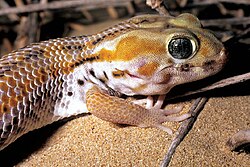| Sphaerodactylidae | |
|---|---|
 | |
| Persian wonder gecko (Teratoscincus keyserlingii ) | |
| Scientific classification | |
| Domain: | Eukaryota |
| Kingdom: | Animalia |
| Phylum: | Chordata |
| Class: | Reptilia |
| Order: | Squamata |
| Infraorder: | Gekkota |
| Superfamily: | Gekkonoidea |
| Family: | Sphaerodactylidae Underwood, 1954 |
| Genera | |
12, see text. | |
The Sphaerodactylidae are a family of geckos (Gekkota) distributed in North America, Central America, South America, and the Caribbean, as well as in Southern Europe, North Africa, the Middle East, and into Central Asia. The family contains 12 living genera and over 200 living species. [2] [3] [4] The family name comes from the ball shape of their finger joints.











